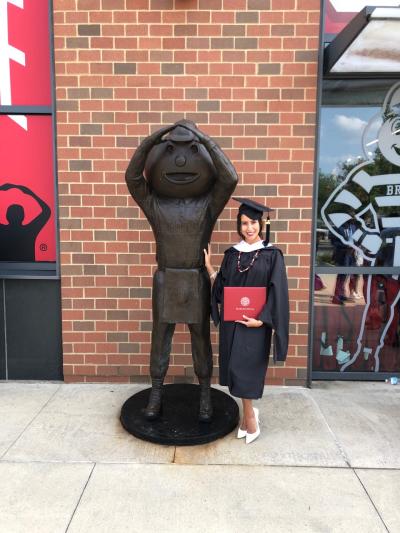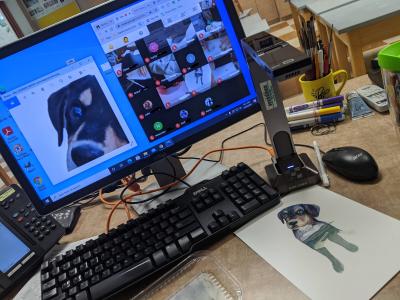By Ruth Smith, Assistant Professor of Teaching, and alumni Esther Roh, Tatiana Piche, Rachel Koral and Lauren Smith
During COVID-19, our online program became a place to learn about how various districts and states responded to the pandemic and racial and political reckonings of 2020 and into 2021. Students in ARTEDU 6998 were asked to reflect on how their experiences in the virtual space of the online MA classroom helped them navigate the challenges of virtual school environments and the pressing need to address social justice issues. Their responses highlighted some important elements of their pedagogy:
- The centrality of relationship with students and the necessity of an “unconventional community support network” of art teachers, many of whom were found online (in addition to the online master’s program, other support networks included art teacher groups on social media and subscriptions to online platforms)
- A curricular focus on social justice and critical multiculturalism, utilizing frameworks from Indigenous studies and critical race theory
- A need to critically explore practices of teachers as well as schools to understand how they work toward or against equity, diversity and justice as well as honor, appropriate or dishonor various cultures and how these practices impact how students understand themselves, their world and their learning
The online MA program continues to champion collaboration and novel approaches using contemporary art and theory to prepare teachers to address the changing needs of their students.
Snapshot No. 1: In ARTEDU 7604 with Esther Roh online MA program second-year, 2020-2022)
One of my favorite aspects of the online MA program was exploring experimentation and play in artistic process. In this project, I was able to choose the work that I wanted to reinterpret using a nonsense strategy. Given random directions provided by classmates. I created multiple iterations of this iconic image, interpreting and implementing the instructions of others. The work pictured here is one of five remakes I created for this assignment. The loss of control as I was fed instructions by others led me to Deleuze’s (1987) “rhizomatic thinking,” which created opportunity to expand my thinking toward possibilities that were not my own. I was able to use various contemporary art references for the girl’s hair and the background of the image, manipulating and reinterpreting the image in five different ways.

Snapshot No. 2: Catching up with Tatiana Piche, dance educator (online MA program, 2019-2021)

In the online MA program, I questioned and addressed socioeconomic barriers to ballet instruction. Dance studios tend to be private businesses, and there is often a lack of diversity. Participation in the balletic arts is costly, but I have found with ingenuity, dance lessons can be implemented in different settings to increase access for students of all socioeconomic backgrounds. This provides exposure and opportunity for participation in communities in which ballet is not accessible. Motivated by how I could better serve my community, participatory action research helped me reimagine my teaching to broaden student demographic participation and to share my experiences.
After graduation, I began a new job as a program specialist for the Boys and Girls Club of The Emerald Coasts’ already established STEM after-school program. It is an honor to work with a motivated team of educators committed to enhancing programming through arts integration, incorporating STEAM curriculum for students after school. I am ecstatic to create the first-ever Dance Club and excited to put my research, ideas and experience into practice to teach ballet with a lens of access and social consciousness.
Online Communities and Multicultural Education: Rachel Koral (2019-2021)
March 6, 2020, was my last day of in-person employment as an elementary school art educator. I took what little materials I thought would be useful from my classroom and prepared myself to work virtually from my kitchen counter, now a converted office. Much like my students, I felt underprepared and ill equipped in the technology department, surrounded by an inadequate learning environment. Most importantly, I had never felt more battered, and my mental health felt fragile.
My master’s program prepared me for this new world of teaching by exposing me to a positive experience of online courses that were structured and challenging, introducing contemporary art making strategies and opportunities to research Indigenous pedagogies. These essential tools helped me introduce multicultural curriculum to public schools during a time of racial injustice, where being able to talk about current events required this framework. Teachers need proper training on how to handle multicultural curriculum, and the art classroom lends itself to social justice inquiry.
I found myself reaching out to my community of local art teachers, museum education curators and those among my online master’s cohort for tips and tricks in this new world of teaching. The topics of conversation covered anywhere from how to properly mount a camera to film an aerial drawing tutorial to how to engage more effectively with students in this new online format. Collaboration within our community led to teachers sharing lesson plans, museum educators filming exhibits or artist talks, and gaining new teaching tools from other educators across the country.
Reflective Practice during the Pandemic: Lauren Smith (2019-2021)

As a full-time teacher, graduate student and mom in 2020, juggling multiple obligations and responsibilities has been challenging this past year. Through reflective practice, the online MA program made teaching during these times easier to navigate. The challenge of online and hybrid teaching forced me to adapt my teaching to new formats and refocus my vision of art education to include creative thinking strategies and provide culturally sustaining and relevant lessons that could be taught online. I began to focus more on showing students why artists create and helping students find parallels to lesson content in their lives.
The online MA program emphasized the importance of using play and experimentation to encourage creativity and thinking through art. I especially loved applying rhizomatic thinking and used Richard Serra's verb list to promote different responses to materials from my students. My multicultural art education coursework opened my eyes to the inequity and misrepresentation of various cultures, perpetuated within art classrooms and communities throughout the nation. I recognized my mishaps and sought contemporary artists of all backgrounds, cultures and races who create thought-provoking, meaningful work to share with my students.
Teaching entirely online has challenged me to modify my teaching approach. I spent a lot of time meeting with high school students in virtual breakout rooms, posting tutorials on Google Classroom and leaving voice-recorded feedback using Mote. I experimented with a variety of formats for art critiques before landing on the use of Padlet to share and discuss artwork in a group setting. Students logged their progress through Google slideshow portfolios. Ideas and solutions were easier to find with my virtual network of art educators. Being an online student myself, I had insights to my students' perspective of the online classroom, reminding me to break down projects into manageable steps and provide plenty of resources to accommodate differentiate learning styles.
